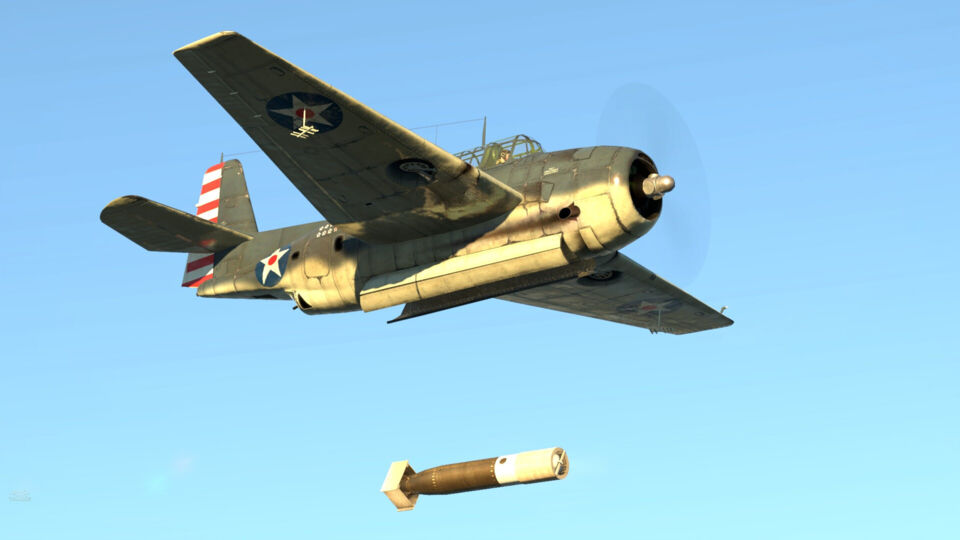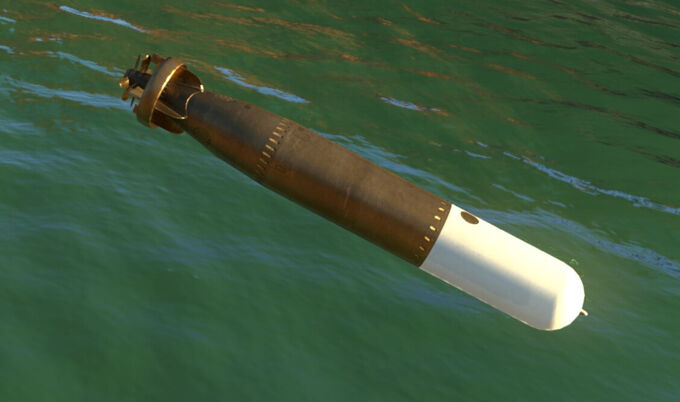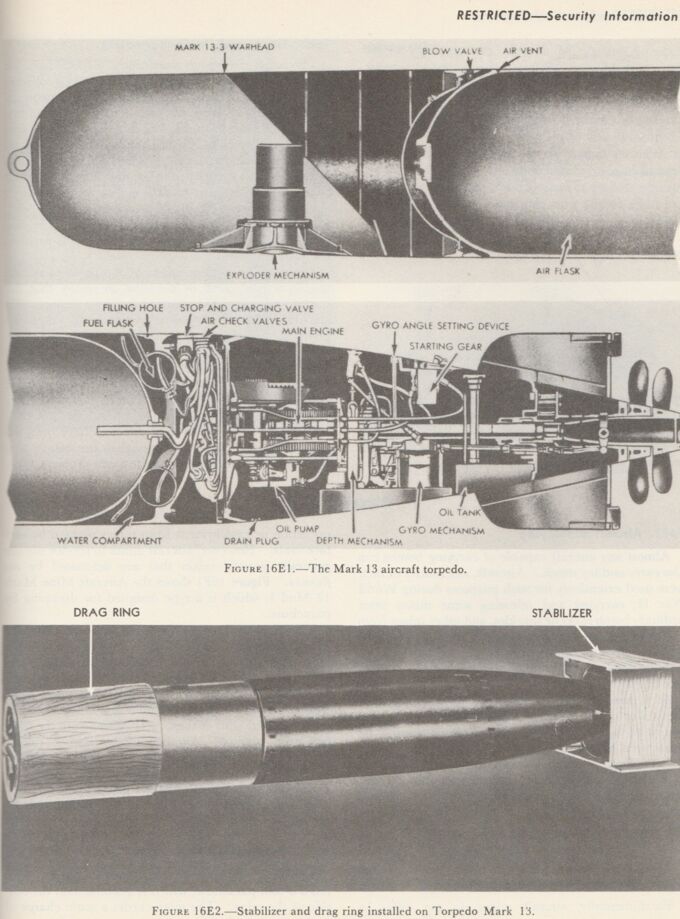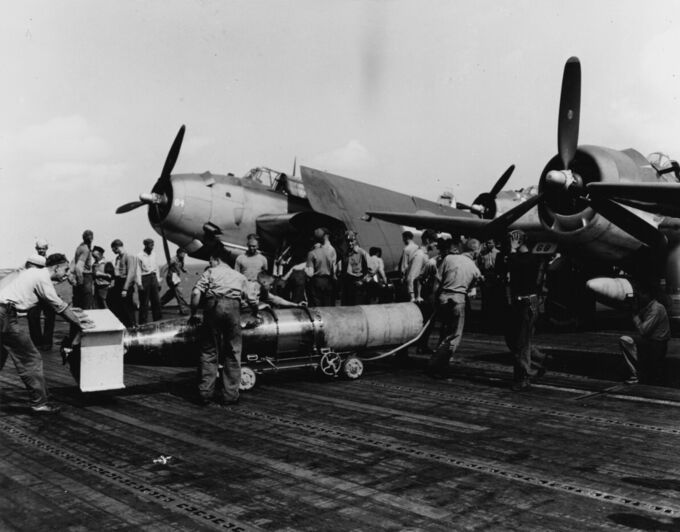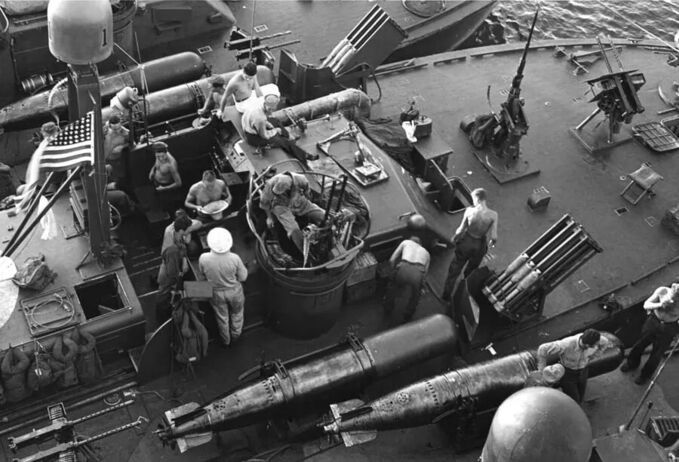The American 22.5-inch Mk.13 torpedo was a problem child for the Navy: it took a long time to design, it was unreliable, and it was not ready for service until 1936. But in the game it became one of the best American torpedoes. It is also available on both aircraft and torpedo boats. Read more about this universal torpedo in the article.
| Pros | Cons |
|---|---|
| Ability to drop from a high altitude and high speed | Aircraft typically only carry one or two at a time |
| Long range | Slow, given enough distance a ship can avoid the torpedo |
General Info
The aircraft torpedo Mk.13 is typically carried on attack-type aircraft, however, there are a few light bombers which can also be outfitted with them. The design of the Mk.13 departed from conventional torpedo design for submarines and destroyers to accommodate being delivered by aircraft and being dropped. Due to the short and stocky size of the torpedoes, they were also ideal to be outfitted on motor torpedo boats where they could either be launched from tubes or just rolled off the side of the boat for more stealthy approaches.
The appearance of this torpedo is similar to many others in that it has the appearance of a mini-submarine which contains an engine, fuel and steering devices. At almost one ton in weight, 600 lbs of it is the detachable warhead which is filled with the highly explosive Torpex.
The Mk.13 torpedo was specifically designed to be used from an aerial platform with a range of 5.7 km with an in-water speed of almost 67 km/h. The Mk.13 designation applies to the entire torpedo assembly as a whole.
The Mk.13-6 Case Torpedo has several modifications, such as Shroud ring, Drag ring and Box stabilizer, allowing it to be dropped from an aircraft at a higher speed and altitude. The torpedo is also faster (74 km/h), but has a smaller range of just 3.6 km.
Effective damage
The Mk.13 torpedo had a large high-explosive warhead compared to the Mk.VII which was frequently used at the time. The Mk.13 has a 600 lb (270 kg) Torpex (Torpedo Explosive) warhead compared the Mk.VII's 466 lb (211 kg) warhead. Torpex is an explosive which is about 50% more powerful than TNT by mass alone. So its TNT equivalent is 450 kg.
Usage in battles
The upgraded Mk.13 torpedo can be utilised against any target which is in the water which can include ships, boats, tanks (at the water's edge), boat-planes or even structures. Due to the higher altitude in which it can be dropped from, the delivering bomber can make a safer approach, release and get-away avoiding ship-board anti-aircraft fire and fighters patrolling around ships.
History
Mark 13
The first purpose-built aerial torpedo, the Mark 13 had a long way to go before seeing combat and even longer way to become an effective combat weapon. The Mark 13 originated from a 1925 design study by the United States Navy. However, to the detriment of the design, it ended in development hell for almost two decades before entering service. The lengthy development cycle came from the changing requirements of the United States Navy. The first attempt was the “Project G-6” design which was cancelled in 1926 just a year after it entered development for a plan make aerial version of the WWI-era Mark 7 torpedoes. In 1927, the Navy changed their mind again and revived the G-6 project which was designated the Mark 13 in August of 1930. By this point, development of the Mark 13 remained uncertain due to the emergence of dive bombers led and the program was cancelled again in October. It was then revived yet again in July of 1931 and in 1936 it was accepted into service. But the acceptance of the Mark 13 would be the ends of its problems.
The production of all torpedo types during the inter-war period was all done by a single factory to supply the entire US Navy, which naturally created a backlog as they couldn’t meet the target goals for torpedo production. Eventually the United States had to arrange for other companies including Pontiac and International Harvester alongside production at the Naval Torpedo Station in Newport, Rhode Island. Even before the US entered the war the flaws of the Mark 13 began to emerge. A training in July 1941 by VT-6 had only one of the 10 torpedoes launched perform a success run with 5 going off course and the remaining four sinking. The problems with the Mark 13 only became more obvious when the United States entered World War II with 39 out of 41 torpedo bombers that were lost at the 1942 Battle of Midway not even scoring a single hit with their torpedoes. In mid-1943, a study of 105 torpedoes dropped from speeds over 150 knots only 31% of torpedoes dropped worked as intended. 36% didn’t even start, 20% sank, 20% had poor deflection performance, 18% did have run at the right depth and 2% ran on the surface. Due to 12 known defects existing in the Mark 13, the Navy decided to develop the Mark 25 to replace with a more effective aerial torpedo.
Due to shortages of the Mark 8 and Mark 10 torpedoes for PT boats in the Pacific Theater, and needing a weapon to counter Imperial Japanese Navy destroyers and cruisers, the Mark 13 was pressed into service on these craft in 1944. The Mark 13’s light weight meant it save as much as 1,400 pounds when installed on PT boats and could be simply rolled over the sides from launch racks instead of using launch tubes. As a result, the Mark 13 did not risk causing burned grease trail that would expose the boat’s firing position. The Mark 13’s final benefit in the PT boat role was its larger 600 pound warhead loaded with torpex which was 50% more powerful than TNT by mass. The Mark 13 had some drawbacks however. Primarily, it was slower than regular torpedoes and had a shorter range, but these were not seen as significant problems for PT boats which relied on stealth to attack large ships.
Despite its troubled history, the Mark 13 was the last aerial torpedo to be used in combat and the last torpedo of any type used by the US Navy. Its final mission occurred during the Korean War where 8 AD-4 Skyraiders launched from USS Princeton flew to destroy Hwachon Dam in South Korea which the North Koreans were using to hinder the movement of United Nations Command floating barges downstream. Due to the improvements made to the design during World War II, the Mark 13 had only two of the 8 torpedoes fail and the remain 6 were more than enough to destroy the dam.
The Mark 13 was unusual for aerial torpedoes in its long but squat dimensions of 22.5 inches in diameter and 13 feet 5 inches. The original Mod 0 torpedoes weighed 1,949 pounds and had between 404 and 392 pounds of TNT, a range of 5,700 yards and a speed of 30 knots. The Mark 13 had a negative buoyancy of 523 pounds, used a Mark 12 Mod 1 gyro for guidance, and was powered by a wet-heater steam turbine. The latter Mod 10 torpedoes were 13 feet 9 inches long and 2,216 pounds. The Mod 10 could accommodate 603 pounds of TNT, 606 pounds of Torpex, or 600 pounds of High Blast Explosive which was developed as a less sensitive version of Torpex.
Mark 13-6
The Mark 13 was the first aerial torpedo accepted into service by the United States Navy, but it had its teething problems for most of the war. It was not a thoroughly tested design before its adoption and when it entered service, it found itself having a reputation for malfunctioning in almost every manner a torpedo could conceivably fail. As a result, modifications were made to the design such as with the Mk 13-6.
The modification of the Mark 13 to the Mark 13-6 Case came from studies by the California Institute of Technology at the Morris Reservoir Naval Weapons Test Site in Los Angeles. By dropping the Mark 13 into the water from a 300-foot slide down the Morris Dam, into the reservoir to study all aspects of the torpedo’s drop into the clear water. The results of the test showed the “low and slow” doctrine of the US Navy’s torpedoes bombers was counterproductive as the flat angle of the torpedo entering the water would damage the mechanism. From these tests, the Mark 13 Mod 2A was created which was more reliable due to less fragile components along with the addition of a water trip delay valve to delay the torpedo from firing when dropped at an altitude higher than 300 feet. The Mark 13-6 uses the Mark 2A as a basis but adds another innovation: the shroud ring.
The idea of the shroud ring ironically came from the Imperial Japanese Navy. To get their Type 91 aerial torpedoes to enter at the proper angle, the IJN added a wood box-shaped tail design to shear off when the torpedo entered the water and ensure it fired at the correct depth. This modification was used to excellent effect during their attack on Pearl Harbor on December 7th, 1941, but the US Navy first observed it May 8th, 1942. On this date during the Battle of the Coral Sea, Captain Fredrick of the USS Lexington noticed the addition of the wooden shroud rings on Type 91 torpedoes from B5N “Kate” torpedo bombers. As the Mark 13’s planned replacement, the Mark 25 was still undergoing development, the Mark 13-6 was built as an interim solution to improve the aerial torpedoes of the US Navy. By February 1944, the Mark 13-6 could be dropped at altitudes of 1,000 feet. Further improvements to the design led to the later Mk. 13-6 Case.
Mark 13-6 Case
The Mark 13-6 Case is a further improvement of the Mark 13 Mod 6 based on the extensive testing of the United States Navy and the designs of their opponents, the Imperial Japanese Navy. The modification of the Mark 13 to the Mark 13-6 Case came from studies by the California Institute of Technology at the Morris Reservoir Naval Weapons Test Site in Los Angeles. By dropping the Mark 13 into the water from a 300-foot slide down the Morris Dam, into the reservoir to study all aspects of the torpedo’s drop into the clear water. The results of the test showed the “low and slow” doctrine of the US Navy’s torpedoes bombers was counterproductive as the flat angle of the torpedo entering the water would damage the mechanism. From these tests, the Mark 13 Mod 2A was created which was more reliable due to less fragile components along with the addition of a water trip delay valve to delay the torpedo from firing when dropped at an altitude higher than 300 feet. The Mark 13-6 uses the Mark 2A as a basis but adds another innovation: the shroud ring.
The idea of the shroud ring ironically came from the Imperial Japanese Navy. In order to get their Type 91 aerial torpedoes to enter at the proper angle, the IJN added a wood box-shaped tail design to shear off when the torpedo entered the water and ensure it fired at the correct depth. This modification was used to excellent effect during their attack on Pearl Harbor on December 7th, 1941, but the US Navy first observed it May 8th, 1942. On this date during the Battle of the Coral Sea, Captain Fredrick of the USS Lexington noticed the addition of the wooden shroud rings on Type 91 torpedoes from B5N “Kate” torpedo bombers. As the Mark 13’s planned replacement, the Mark 25 was still undergoing development, the Mark 13-6 was built as an interim solution to improve the aerial torpedoes of the US Navy. Further improvements to the design led to the later Mk. 13-6 Case.
The Mark 13-6 Case features the further addition of the nose ring to the torpedo design. Known in service as the “pickle barrel”, the nose rings provided drag the Mark 13 slowing down its descent in the air by 40% and allowing the torpedo to maintain its intended course. It also cushioned the impact of the Mark 13-6 hitting the water to prevent damage to the internal components, another innovation from the CIT tests at the Morris Reservoir. The Mark 13-6 uses a lanyard that shears off when it hits the water. When the lanyard breaks, fuel is fed into the combustion chamber. This modification, done to prevent the turbine from burning out, reduced the range by 4,000 yards, but it was balanced out by the increased reliability which kept the Mark 13 in service until 1951.
